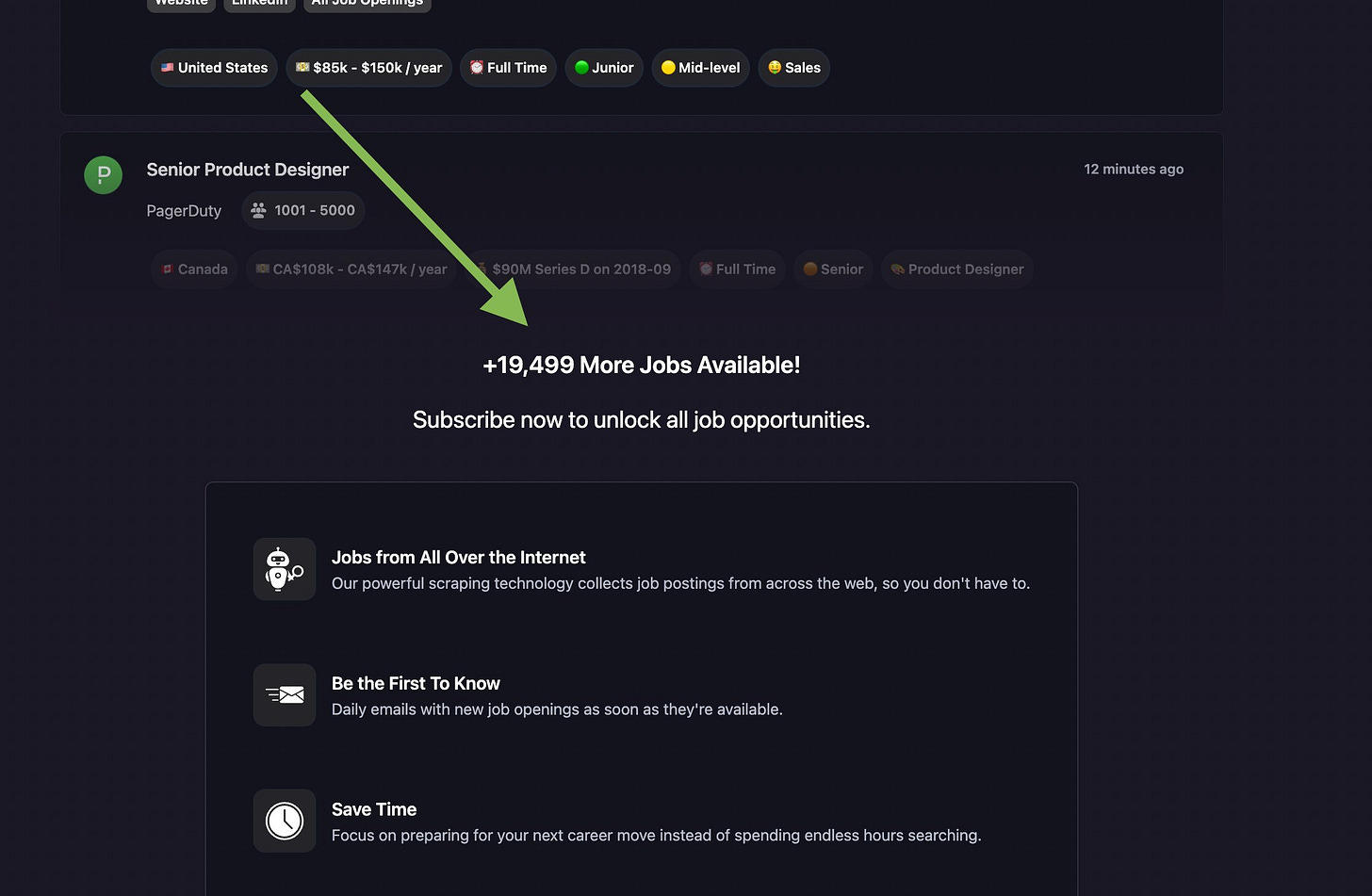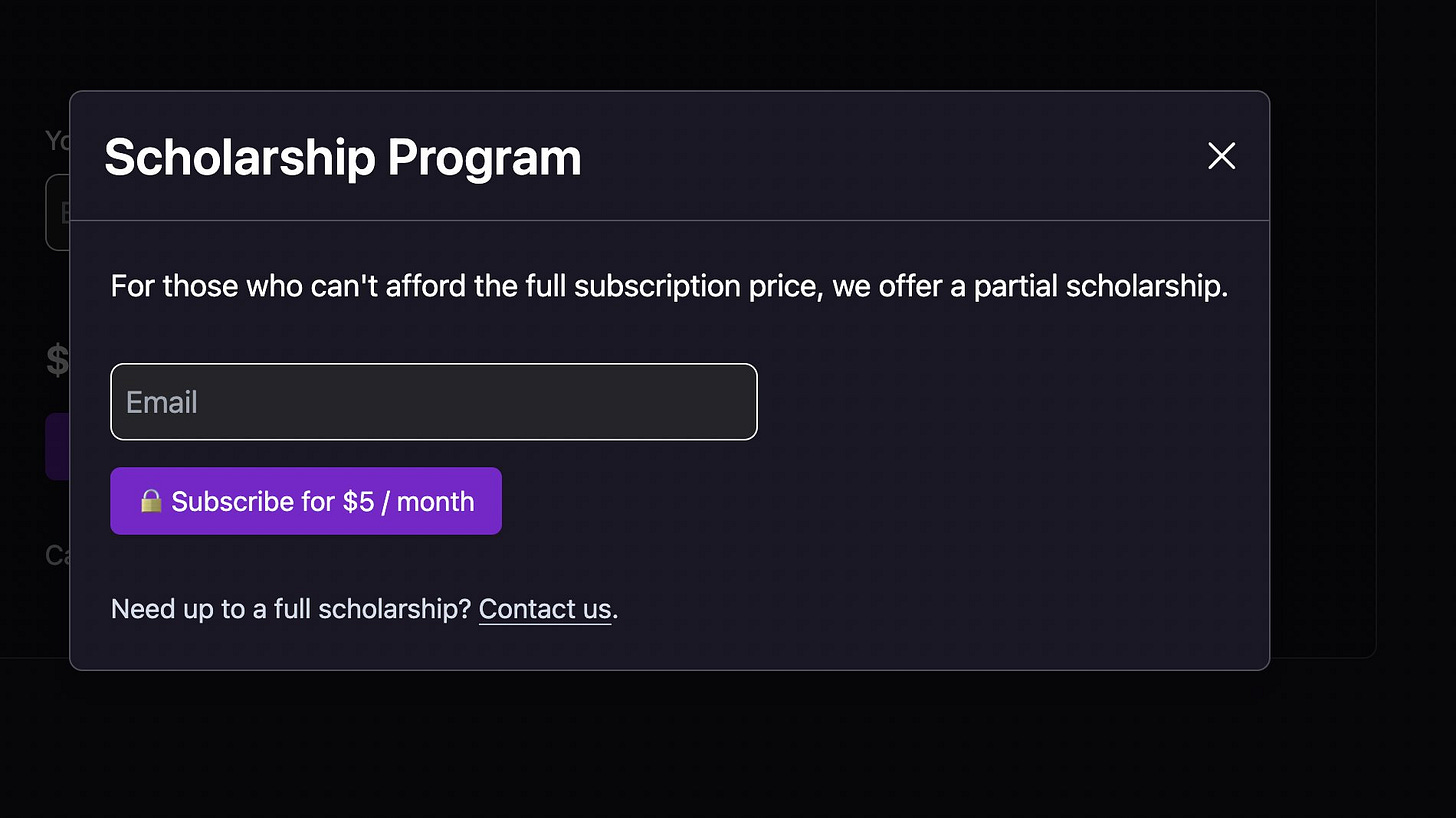6 pricing A/B tests I’ve run (and which ones worked)
How pricing experiments helped me reach $6,000 MRR
It’s been a while since my last post on getting to 19,000 monthly clicks from Google. Since then, I’m happy to say that my job board, Remote Rocketship, has grown to $6,000 MRR! 🎉
Here is a brief look back on how long it took to get here:
$0 → $1 took 4 months
$1 → $2,000 took 2 months
$2,000 → $4,000 took 3 months
$4,000 → $6,000 took 2 months.
A big part of achieving this was experimenting with different pricing strategies. In fact, so far I’ve run 6 different A/B tests on it.
In this post, I want to share what each of these tests were and their (often surprising) results.
1. Moving the job board behind a paywall
This was my first step towards monetizing Remote Rocketship. Prior to this, people could search for jobs on the site for free. In the meantime, I was trying to monetize by asking companies to pay for promoted posts.
However, despite having 60,000 monthly visitors to the site, I didn’t get any interest from companies – probably because all the tech layoffs mean that companies are getting way too many candidates right now.
So I decided to change the business model: Instead of charging companies to promote their posts, I charged job seekers $10/month to use the site.
At first, I was quite hesitant to do this. I was worried that putting up a paywall would kill traffic to the site. That said, I wasn’t making any money from the site either, so I didn’t have much to lose 🤷🏻♂️
Experiment setup
Hypothesis: Because Remote Rocketship provides value to job seekers, job seekers will be willing to pay for access to the site.
🔬 Control group (90% of users)– Free access to the site.
🧪 Test group (10% of users) – $10/month subscription required to use the site.
✅ Result:
10 paying subscribers after two weeks 🎉
Traffic to the site decreases by 50%.
This was enough validation for me that people are willing to pay for the site and so I put it behind a paywall!
2. Doubling the price from $10/month to $20/month
🔬Hypothesis: Doubling the price will decrease the number of signups but will increase revenue.
🧪 Control group – $10/month to use the site.
🧪 Test group – $20/month.
❌ Result:
66% decrease in signups.
35% less revenue.
I was disappointed with this result but glad I ran it as an A/B test. I set the price back to $10/month afterwards.
3. Adding a 2-day free trial
🔬 Hypothesis: Having a free trial will convince people who are on the fence to sign up, ultimately increasing revenue
🧪Control group – $10/month to use the site.
🧪Test group – 2-day free trial, then $10/month.
❌ Result:
No change in signups.
Many people in the test group canceled before their free trial ended, resulting in less revenue.
4. Offering half-price and free “scholarships“
I wanted to see if there are people who would be willing to pay $5/month but not $10/month. I didn’t want to halve the price for everyone, though, so I offered “scholarships”.
🔬 Hypothesis: Offering half-price and free subscriptions would increase the number of signups. Some people who would have paid $10 per month will end up requesting a scholarship anyway, but overall, revenue will increase.
🧪 Control group – $10/month to use the site.
🧪 Test group – An option on the signup form “Can’t afford a subscription? Click here”. Users could then buy a half-price subscription for $5/month or even email me for a free subscription.
❌ Result:
Signups increased by 30%.
Overall revenue remained the same.
I decided not to ship the experiment and keep pricing at $10/month for everyone since it’s simpler.
5. Weekly subscriptions instead of monthly
The idea for this experiment came from the founder of Teal, a tool for job seekers. He mentioned that job seekers don’t expect to be searching for a job for a long time, so monthly subscriptions feel like a big commitment.
🔬 Hypothesis: Charging $5/week instead of $10/month is a way to double the price without decreasing signups. It will also lead to higher churn, but overall revenue will increase.
🧪 Control group – $10/month to use the site.
🧪 Test group – $5/week
🟰 Result:
Signups remained the same
Churn increased
Overall revenue remained the same.
I decided to make $5/week pricing standard on the site so that I can run the next experiment (below).
6. Offer weekly, monthly, and yearly subscriptions
🔬 Hypothesis: Offering users the choice between subscriptions will increase customer lifetime value.
🧪 Control group – $5/week to use the site.
🧪 Test group – Option to choose between $5/week, $18/month, or $60/year.
✅ Result after one month:
Revenue doubles! 🤯
LTV increases from $35 to $45 per user.
In the test group, 55% of people signed up for weekly subscriptions, 30% for monthly, and 15% for annual.
This was by far the experiment which surprised me the most. I was not expecting such a big increase in revenue!
Conclusion
So many of these experiments had results I did not expect, and my biggest takeaway from running all these experiments is that it’s super important to A/B test any pricing changes – otherwise you might end up shipping something that decreases.
Thanks for reading! I hope you enjoyed it and maybe even picked up an idea or two to try out for your own SaaS. If you have ideas for other experiments I should run, do let me know 🙂








Just came across this post now Lior - really epic!!
Out of interest how were you able to segment the control group from the test group? Like how did you do that for new users and visitors on your website?
This is really cool. I have a job board that I have not officially launched. I just did some link building though prospecting and outreach and I have around 1.2k unique visitors per month.
The data source is similar to yours but I don't really have tech skills, so I compiled a database of around 500 companies whose career pages I check regularly.
Just curious, what is your current traffic?